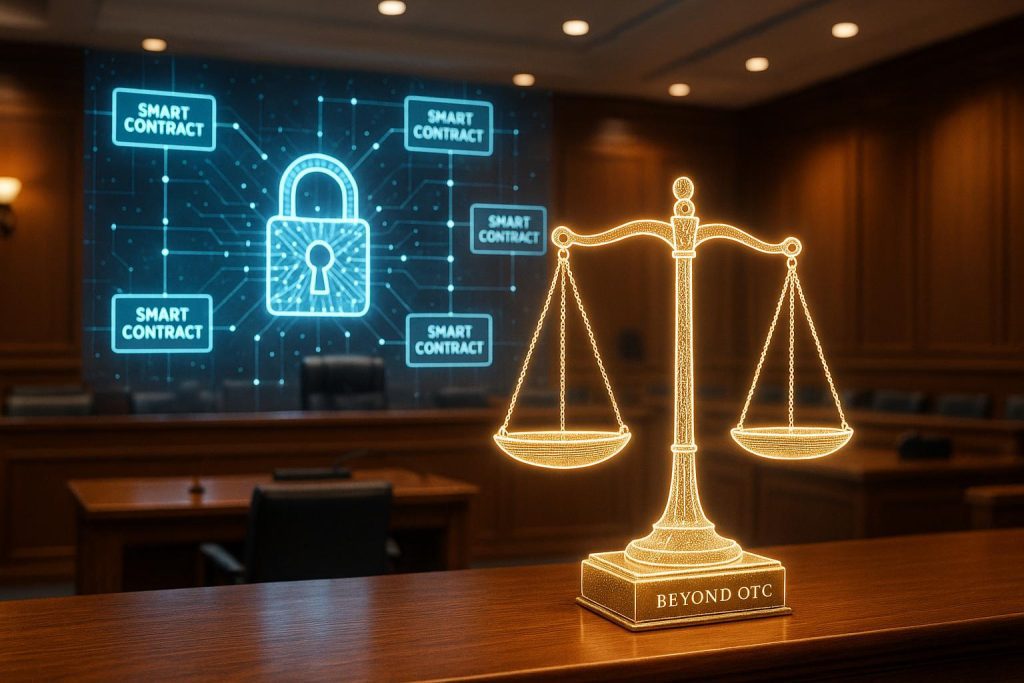Smart contracts can fail. When they do, who’s responsible? Here’s a quick breakdown:
- Developers: Accountable for coding errors, security flaws, and inadequate documentation.
- Users: Mistakes like incorrect inputs or mismanaging access controls can lead to issues.
- External Factors: Network congestion, oracle failures, or blockchain infrastructure problems can complicate liability.
Key Takeaways:
- Liability depends on the failure type: Was it a coding error, user mistake, or external issue?
- Legal challenges exist: Smart contracts must meet legal contract requirements (offer, acceptance, intent, etc.).
- Cross-border issues add complexity: Jurisdiction, applicable laws, and enforcement can be tricky.
How to reduce risks:
- Conduct thorough testing and audits.
- Provide clear documentation for users.
- Consult legal and blockchain experts to ensure compliance and security.
Smart contracts simplify transactions but navigating their failures requires careful planning and expertise.
Where Crypto Companies Go Wrong with Sophia Zaller …
Types of Smart Contract Failures
Smart contracts can fail in several ways, disrupting operations and causing complications. Here’s an overview to help understand the different failure types, which ties into liability discussions later.
Code and Security Issues
Problems in the programming or security of a smart contract often stem from insufficient testing or design flaws. These issues can significantly undermine the contract’s functionality:
- Logic errors: Flaws in the core programming that lead to unexpected outcomes.
- Reentrancy vulnerabilities: Security gaps that allow attackers to repeatedly call functions, potentially draining funds.
- Integer overflow/underflow: Calculation errors that can manipulate contract values.
- Gas optimization issues: Inefficient code leading to transaction failures when gas limits are exceeded.
These issues can result in serious financial losses for users or organizations.
User Operation Mistakes
Smart contract failures aren’t always about the code. Sometimes, user errors play a role, often due to misunderstandings or incorrect usage of the contract:
- Parameter input errors: Entering incorrect transaction values or data.
- Authorization mistakes: Mismanaging or failing to set proper access controls.
- Timing issues: Missing critical deadlines or execution windows.
- Interface confusion: Misinterpreting the contract’s requirements or capabilities.
Even minor user mistakes can have significant consequences when interacting with smart contracts.
Outside Risk Factors
Sometimes, external elements beyond the control of the smart contract itself can cause failures. These external risks include:
| Risk Factor | Impact | Common Examples |
|---|---|---|
| Network Congestion | Delayed transactions | Block space competition during busy periods |
| Oracle Failures | Incorrect data inputs | Manipulated or unavailable price feeds |
| Chain Reorganizations | Transaction reversals | Network splits or consensus issues |
| Infrastructure Issues | Service disruptions | Node outages or API failures |
The broader blockchain ecosystem plays a critical role in smart contract reliability. When external risks materialize, pinpointing liability becomes challenging, as the failure might not be tied to any single party. Understanding these failure types is essential for assessing responsibility, which will be explored further in the next section.
Parties Responsible for Smart Contract Failures
Developer Responsibilities
When smart contracts fail due to coding mistakes or security vulnerabilities, the responsibility often falls on developers. Their role includes ensuring the contract’s reliability by focusing on:
- Writing reliable code: Ensuring the code is efficient and free from errors.
- Implementing strong security measures: Protecting the contract from potential threats.
- Providing clear documentation: Offering detailed technical instructions for proper use and thorough review.
Up next, we’ll look at the role of platforms within the smart contract ecosystem.
sbb-itb-7e716c2
Smart Contract Law and Enforcement
Legal Contract Requirements
For smart contracts to hold up in court, they need to meet the basic requirements of a legal contract. These include:
- Valid offer and acceptance: The code must accurately reflect the agreement between the parties involved.
- Consideration: Both sides must exchange something of value, whether it’s money, goods, or services.
- Legal intent: The parties must show they intend to create obligations that are legally binding.
- Capacity: Everyone involved must have the legal authority to enter into a contract.
Courts are still figuring out how to interpret smart contracts in a legal context, translating code into terms that align with existing laws. This process is essential for tackling more complex challenges, especially when dealing with international disputes.
Cross-Border Legal Issues
Smart contracts operating across different countries bring unique enforcement and liability challenges. Some key points to address include:
- Jurisdiction determination: Deciding which court has the authority to handle disputes.
- Applicable law: Identifying which country’s legal system governs the contract.
- Enforcement mechanisms: Ensuring court rulings can be implemented across borders.
Blockchain’s decentralized nature makes these issues tricky. Jurisdiction, in particular, becomes harder to pinpoint when contracts aren’t tied to a specific location. Platforms like BeyondOTC help bridge this gap by connecting users with experts in both legal and technical fields, making it easier to navigate these challenges.
Resolving Contract Disputes
When disputes arise, alternative dispute resolution (ADR) methods like arbitration are gaining traction. Arbitration is especially useful for handling conflicts that span multiple jurisdictions or involve technical details that traditional courts may struggle with. As legal systems adapt to the rise of smart contracts, ADR offers a quicker and more specialized way to resolve issues while still aligning with established legal principles.
Next, we’ll look at strategies to manage risks and minimize vulnerabilities in smart contracts.
Smart Contract Risk Management
Testing and Security Audits
Thorough testing and security audits are essential to avoid failures in smart contracts. This process combines automated tools and manual reviews to catch potential issues.
Key phases of audits include:
- Static Analysis: Automated tools scan the code for common vulnerabilities.
- Dynamic Testing: Live testing is conducted using a variety of input scenarios.
- Formal Verification: Mathematical proofs ensure the contract behaves as intended.
- Penetration Testing: Simulated attacks help identify security weak points.
Backing up these tests with clear documentation ensures responsibilities and procedures are well-defined.
Contract Documentation
Proper documentation is critical for transparency and usability. Here’s what to include:
| Documentation Component | Purpose | Key Elements |
|---|---|---|
| Technical Specifications | Define contract behavior | Function descriptions, state variables, access controls |
| User Guidelines | Explain proper usage | Step-by-step instructions, risk warnings, limitations |
| Audit Reports | Verify security measures | Vulnerability assessments, remediation steps, certification |
| Legal Framework | Establish liability terms | Jurisdiction, dispute resolution, user obligations |
Comprehensive documentation not only supports technical clarity but also ensures users and stakeholders understand the contract’s scope and limitations.
Expert Consultation
Engaging blockchain and legal experts is a key step in reducing risks. Their input is invaluable during both the development and deployment stages, particularly in these areas:
- Technical Architecture: Ensuring the contract is designed securely and functions as intended.
- Legal Compliance: Addressing regulatory requirements across different regions.
- Risk Assessment: Identifying vulnerabilities and creating strategies to address them.
Specialists provide tailored advice and due diligence, ensuring all risks are addressed. For instance, BeyondOTC connects clients with experienced professionals to guide them through the entire smart contract lifecycle.
Conclusion
Combining technical accuracy, platform reliability, and user awareness is essential for managing smart contract liability. Achieving this balance requires precise coding, dependable infrastructure, and a clear understanding of contract limitations.
To address potential risks and responsibilities, here are three practical steps to reduce liabilities:
- Clear Documentation: Establish well-defined guidelines that outline liability boundaries.
- Expert Review: Involve professionals to identify and address vulnerabilities early.
- Ongoing Risk Management: Conduct regular security audits and implement thorough testing procedures.
For navigating both regulatory and technical complexities, working with specialists can make all the difference. BeyondOTC offers legal consultancy services to connect projects with blockchain legal experts.
FAQs
How can developers minimize the risk of smart contract failures caused by coding errors or security vulnerabilities?
Developers can reduce the risk of smart contract failures by following best practices in coding and security. First, they should conduct thorough testing using tools like unit tests and simulation environments to identify potential bugs or vulnerabilities. Second, code audits performed by independent, experienced security professionals can help uncover issues that might go unnoticed. Third, leveraging formal verification methods can ensure the smart contract behaves as intended under all conditions. Finally, developers should stay updated on the latest security threats and implement secure coding practices to mitigate risks. By taking these steps, they can build more reliable and secure smart contracts.
How are disputes involving smart contracts handled, especially across international borders?
Disputes involving smart contracts can be complex, particularly when they span multiple countries. Legal systems often struggle to address these issues due to the decentralized and borderless nature of blockchain technology. Jurisdictional challenges arise, as it’s not always clear which country’s laws should apply.
In most cases, resolution depends on the specific terms coded into the smart contract and whether parties have agreed to a governing jurisdiction. However, enforcement can be tricky when international laws conflict or when the parties involved are anonymous. Consulting legal experts familiar with blockchain and international law is often necessary to navigate these disputes effectively.
How do external factors like network congestion and oracle failures impact smart contract liability, and what can be done to reduce these risks?
External factors such as network congestion and oracle failures can significantly impact the functionality of smart contracts and raise questions about liability. For instance, network congestion can delay transactions, while oracle failures might provide inaccurate or outdated data to the contract, leading to unintended outcomes.
To mitigate these risks, developers can implement robust testing and fail-safe mechanisms, such as fallback options for oracles or transaction timeouts. Users should also carefully review the terms and limitations of the smart contract before interacting with it. By taking these precautions, both developers and users can help minimize potential liabilities and ensure smoother operations.




